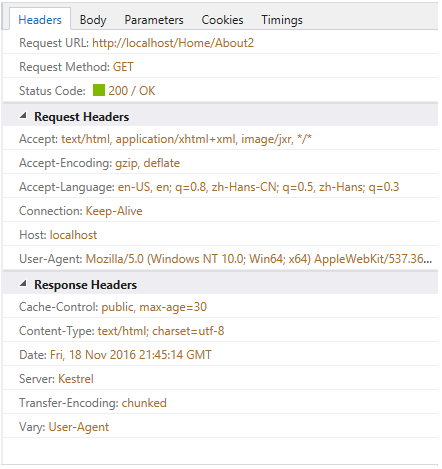Response Caching
By John Luo, Rick Anderson, and Steve Smith
What is Response Caching
Response caching adds cache-related headers to responses. These headers specify how you want client, proxy and middleware to cache responses. Response caching can reduce the number of requests a client or proxy makes to the web server. Response caching can also reduce the amount of work the web server performs to generate the response.
The primary HTTP header used for caching is Cache-Control. See the HTTP 1.1 Caching for more information. Common cache directives:
The web server can cache responses by adding the response caching middleware. See Response caching middleware for more information.
ResponseCache Attribute
The ResponseCacheAttribute specifies the parameters necessary for setting appropriate headers in response caching. See ResponseCacheAttribute for a description of the parameters.
警告
Disable caching for content that contains information for authenticated clients. Caching should only be enabled for content that does not change based on a user's identity, or whether a user is logged in.
VaryByQueryKeys string[] (requires ASP.NET Core 1.1.0 and higher): When set, the response caching middleware will vary the stored response by the values of the given list of query keys. The response caching middleware must be enabled to set the VaryByQueryKeys property, otherwise a runtime exception will be thrown. There is no corresponding HTTP header for the VaryByQueryKeys property. This property is an HTTP feature handled by the response caching middleware. For the middleware to serve a cached response, the query string and query string value must match a previous request. For example, consider the following sequence:
| Request | Result |
|---|---|
http://example.com?key1=value1 |
returned from server |
http://example.com?key1=value1 |
returned from middleware |
http://example.com?key1=value2 |
returned from server |
The first request is returned by the server and cached in middleware. The second request is returned by middleware because the query string matches the previous request. The third request is not in the middleware cache because the query string value doesn't match a previous request.
The ResponseCacheAttribute is used to configure and create (via IFilterFactory) a ResponseCacheFilter. The ResponseCacheFilter performs the work of updating the appropriate HTTP headers and features of the response. The filter:
- Removes any existing headers for
Vary,Cache-Control, andPragma. - Writes out the appropriate headers based on the properties set in the
ResponseCacheAttribute. - Updates the response caching HTTP feature if
VaryByQueryKeysis set.
Vary
This header is only written when the VaryByHeader property is set. It is set to the Vary property's value. The following sample uses the VaryByHeader property.
[ResponseCache(VaryByHeader = "User-Agent", Duration = 30)]
public IActionResult About2()
{
You can view the response headers with your browsers network tools. The following image shows the Edge F12 output on the Network tab when the About2 action method is refreshed.

NoStore and Location.None
NoStore overrides most of the other properties. When this property is set to true, the Cache-Control header will be set to "no-store". If Location is set to None:
Cache-Controlis set to"no-store, no-cache".Pragmais set tono-cache.
If NoStore is false and Location is None, Cache-Control and Pragma will be set to no-cache.
You typically set NoStore to true on error pages. For example:
[ResponseCache(Location = ResponseCacheLocation.None, NoStore = true)]
public IActionResult Error()
{
return View();
}
This will result in the following headers:
Cache-Control: no-store,no-cache
Pragma: no-cache
Location and Duration
To enable caching, Duration must be set to a positive value and Location must be either Any (the default) or Client. In this case, the Cache-Control header will be set to the location value followed by the "max-age" of the response.
备注
Location's options of Any and Client translate into Cache-Control header values of public and private, respectively. As noted previously, setting Location to None will set both Cache-Control and Pragma headers to no-cache.
Below is an example showing the headers produced by setting Duration and leaving the default Location value.
[ResponseCache(Duration = 60)]
public IActionResult Contact()
{
ViewData["Message"] = "Your contact page.";
return View();
}
Produces the following headers:
Cache-Control: public,max-age=60
Cache Profiles
Instead of duplicating ResponseCache settings on many controller action attributes, cache profiles can be configured as options when setting up MVC in the ConfigureServices method in Startup. Values found in a referenced cache profile will be used as the defaults by the ResponseCache attribute, and will be overridden by any properties specified on the attribute.
Setting up a cache profile:
public void ConfigureServices(IServiceCollection services)
{
services.AddMvc(options =>
{
options.CacheProfiles.Add("Default",
new CacheProfile()
{
Duration = 60
});
options.CacheProfiles.Add("Never",
new CacheProfile()
{
Location = ResponseCacheLocation.None,
NoStore = true
});
});
}
Referencing a cache profile:
[ResponseCache(Duration = 30)]
public class HomeController : Controller
{
[ResponseCache(CacheProfileName = "Default")]
public IActionResult Index()
{
return View();
}
The ResponseCache attribute can be applied both to actions (methods) as well as controllers (classes). Method-level attributes will override the settings specified in class-level attributes.
In the above example, a class-level attribute specifies a duration of 30 seconds while a method-level attributes references a cache profile with a duration set to 60 seconds.
The resulting header:
Cache-Control: public,max-age=60